Communication in Health: Interview, Skills, and Johari Window Analysis
VerifiedAdded on 2023/06/04
|7
|1479
|97
Essay
AI Summary
This essay delves into the critical role of communication in healthcare, emphasizing the skills required for effective interaction and self-awareness. It discusses the communication process, highlighting the importance of speaking, listening, and personal relationship skills. The essay reflects on an interview conducted with a nurse, Ms. Edna, analyzing the application of these skills and the challenges encountered, such as the limitations of writing and nonverbal communication. Furthermore, it incorporates the Johari Window model to assess self-awareness during the interview process, acknowledging personal strengths, limitations, and values. The essay concludes by reiterating the significance of communication in nursing, emphasizing the need for continuous learning and the development of interpersonal skills to foster effective dialogue and build strong relationships within the healthcare environment. Desklib provides access to similar solved assignments and resources for students.
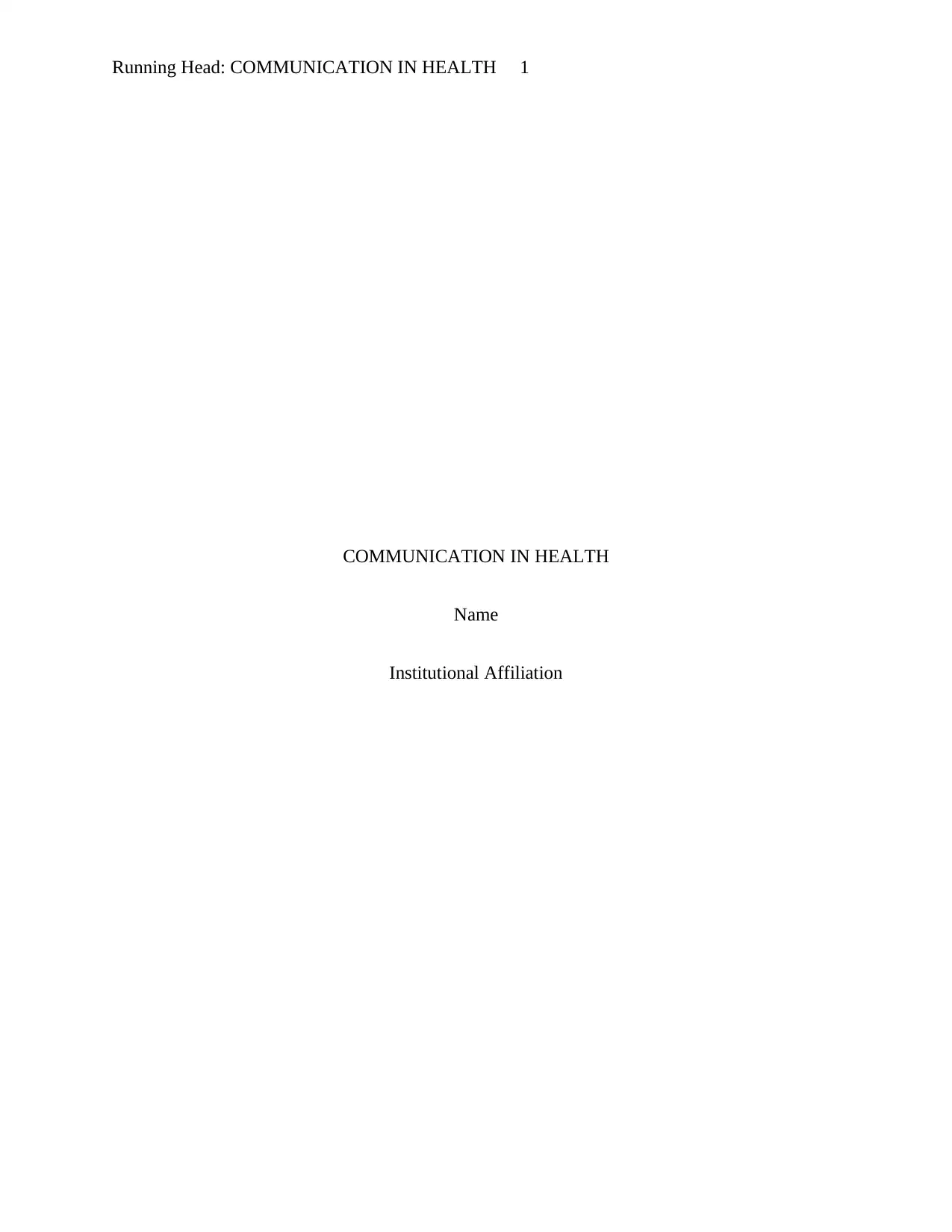
Running Head: COMMUNICATION IN HEALTH 1
COMMUNICATION IN HEALTH
Name
Institutional Affiliation
COMMUNICATION IN HEALTH
Name
Institutional Affiliation
Paraphrase This Document
Need a fresh take? Get an instant paraphrase of this document with our AI Paraphraser
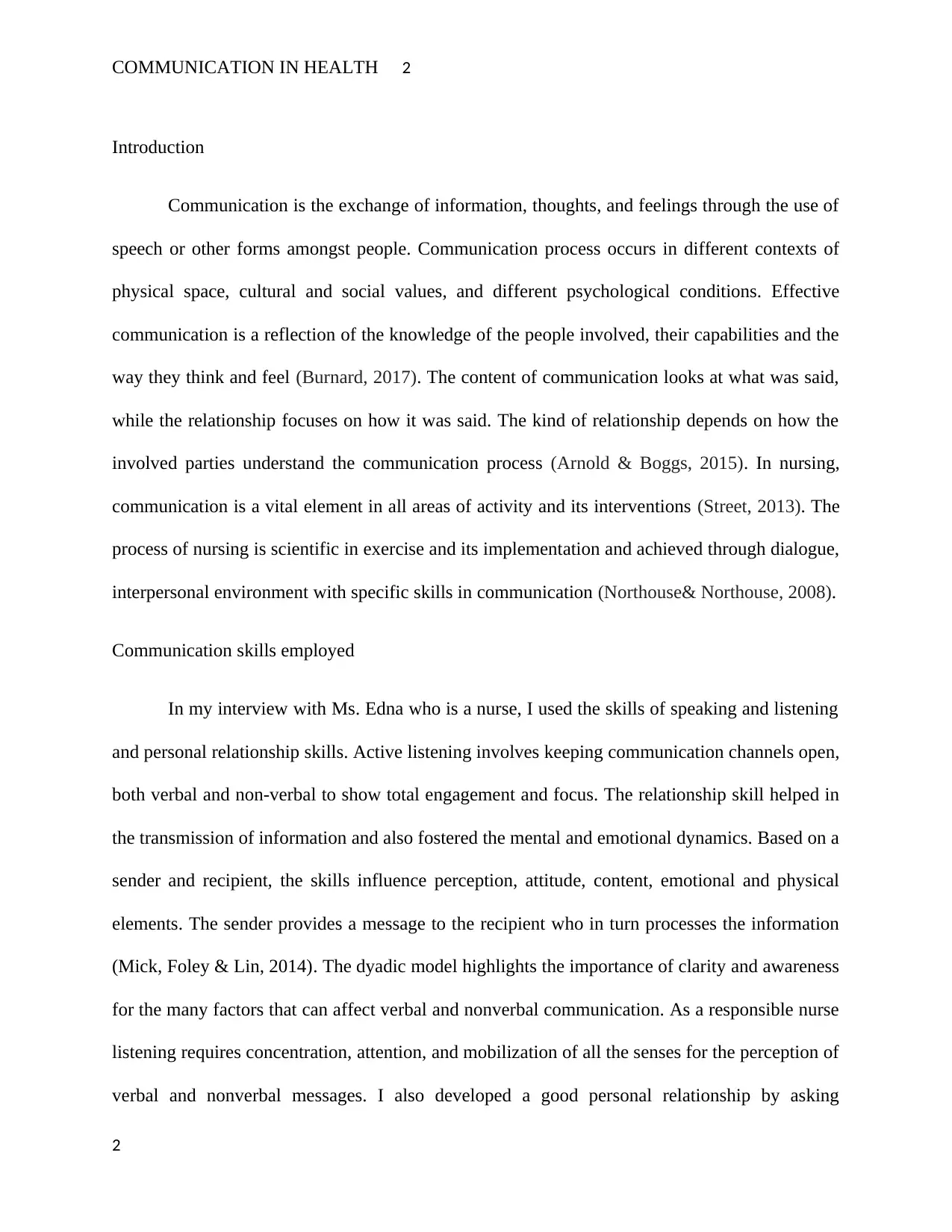
COMMUNICATION IN HEALTH 2
Introduction
Communication is the exchange of information, thoughts, and feelings through the use of
speech or other forms amongst people. Communication process occurs in different contexts of
physical space, cultural and social values, and different psychological conditions. Effective
communication is a reflection of the knowledge of the people involved, their capabilities and the
way they think and feel (Burnard, 2017). The content of communication looks at what was said,
while the relationship focuses on how it was said. The kind of relationship depends on how the
involved parties understand the communication process (Arnold & Boggs, 2015). In nursing,
communication is a vital element in all areas of activity and its interventions (Street, 2013). The
process of nursing is scientific in exercise and its implementation and achieved through dialogue,
interpersonal environment with specific skills in communication (Northouse& Northouse, 2008).
Communication skills employed
In my interview with Ms. Edna who is a nurse, I used the skills of speaking and listening
and personal relationship skills. Active listening involves keeping communication channels open,
both verbal and non-verbal to show total engagement and focus. The relationship skill helped in
the transmission of information and also fostered the mental and emotional dynamics. Based on a
sender and recipient, the skills influence perception, attitude, content, emotional and physical
elements. The sender provides a message to the recipient who in turn processes the information
(Mick, Foley & Lin, 2014). The dyadic model highlights the importance of clarity and awareness
for the many factors that can affect verbal and nonverbal communication. As a responsible nurse
listening requires concentration, attention, and mobilization of all the senses for the perception of
verbal and nonverbal messages. I also developed a good personal relationship by asking
2
Introduction
Communication is the exchange of information, thoughts, and feelings through the use of
speech or other forms amongst people. Communication process occurs in different contexts of
physical space, cultural and social values, and different psychological conditions. Effective
communication is a reflection of the knowledge of the people involved, their capabilities and the
way they think and feel (Burnard, 2017). The content of communication looks at what was said,
while the relationship focuses on how it was said. The kind of relationship depends on how the
involved parties understand the communication process (Arnold & Boggs, 2015). In nursing,
communication is a vital element in all areas of activity and its interventions (Street, 2013). The
process of nursing is scientific in exercise and its implementation and achieved through dialogue,
interpersonal environment with specific skills in communication (Northouse& Northouse, 2008).
Communication skills employed
In my interview with Ms. Edna who is a nurse, I used the skills of speaking and listening
and personal relationship skills. Active listening involves keeping communication channels open,
both verbal and non-verbal to show total engagement and focus. The relationship skill helped in
the transmission of information and also fostered the mental and emotional dynamics. Based on a
sender and recipient, the skills influence perception, attitude, content, emotional and physical
elements. The sender provides a message to the recipient who in turn processes the information
(Mick, Foley & Lin, 2014). The dyadic model highlights the importance of clarity and awareness
for the many factors that can affect verbal and nonverbal communication. As a responsible nurse
listening requires concentration, attention, and mobilization of all the senses for the perception of
verbal and nonverbal messages. I also developed a good personal relationship by asking
2
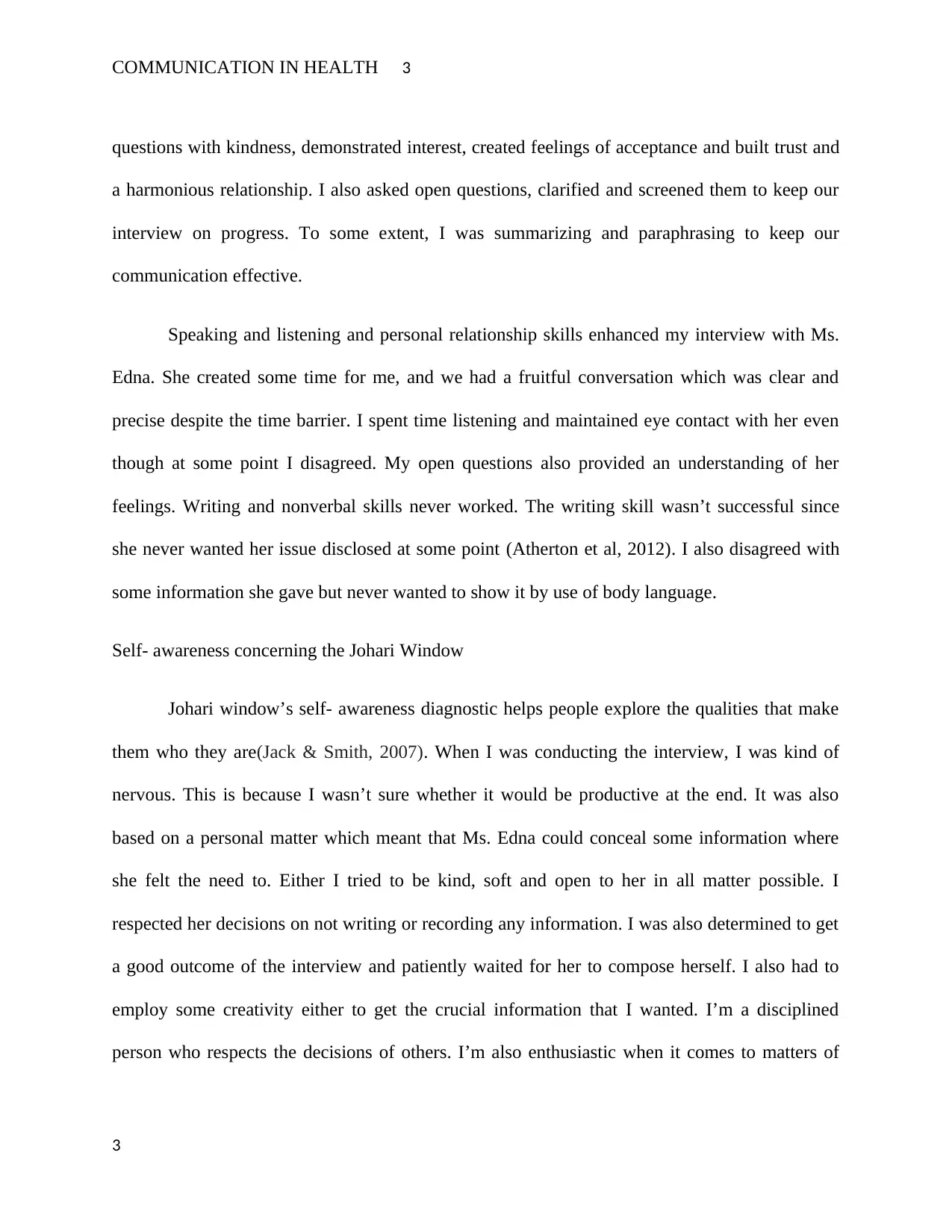
COMMUNICATION IN HEALTH 3
questions with kindness, demonstrated interest, created feelings of acceptance and built trust and
a harmonious relationship. I also asked open questions, clarified and screened them to keep our
interview on progress. To some extent, I was summarizing and paraphrasing to keep our
communication effective.
Speaking and listening and personal relationship skills enhanced my interview with Ms.
Edna. She created some time for me, and we had a fruitful conversation which was clear and
precise despite the time barrier. I spent time listening and maintained eye contact with her even
though at some point I disagreed. My open questions also provided an understanding of her
feelings. Writing and nonverbal skills never worked. The writing skill wasn’t successful since
she never wanted her issue disclosed at some point (Atherton et al, 2012). I also disagreed with
some information she gave but never wanted to show it by use of body language.
Self- awareness concerning the Johari Window
Johari window’s self- awareness diagnostic helps people explore the qualities that make
them who they are(Jack & Smith, 2007). When I was conducting the interview, I was kind of
nervous. This is because I wasn’t sure whether it would be productive at the end. It was also
based on a personal matter which meant that Ms. Edna could conceal some information where
she felt the need to. Either I tried to be kind, soft and open to her in all matter possible. I
respected her decisions on not writing or recording any information. I was also determined to get
a good outcome of the interview and patiently waited for her to compose herself. I also had to
employ some creativity either to get the crucial information that I wanted. I’m a disciplined
person who respects the decisions of others. I’m also enthusiastic when it comes to matters of
3
questions with kindness, demonstrated interest, created feelings of acceptance and built trust and
a harmonious relationship. I also asked open questions, clarified and screened them to keep our
interview on progress. To some extent, I was summarizing and paraphrasing to keep our
communication effective.
Speaking and listening and personal relationship skills enhanced my interview with Ms.
Edna. She created some time for me, and we had a fruitful conversation which was clear and
precise despite the time barrier. I spent time listening and maintained eye contact with her even
though at some point I disagreed. My open questions also provided an understanding of her
feelings. Writing and nonverbal skills never worked. The writing skill wasn’t successful since
she never wanted her issue disclosed at some point (Atherton et al, 2012). I also disagreed with
some information she gave but never wanted to show it by use of body language.
Self- awareness concerning the Johari Window
Johari window’s self- awareness diagnostic helps people explore the qualities that make
them who they are(Jack & Smith, 2007). When I was conducting the interview, I was kind of
nervous. This is because I wasn’t sure whether it would be productive at the end. It was also
based on a personal matter which meant that Ms. Edna could conceal some information where
she felt the need to. Either I tried to be kind, soft and open to her in all matter possible. I
respected her decisions on not writing or recording any information. I was also determined to get
a good outcome of the interview and patiently waited for her to compose herself. I also had to
employ some creativity either to get the crucial information that I wanted. I’m a disciplined
person who respects the decisions of others. I’m also enthusiastic when it comes to matters of
3
⊘ This is a preview!⊘
Do you want full access?
Subscribe today to unlock all pages.

Trusted by 1+ million students worldwide
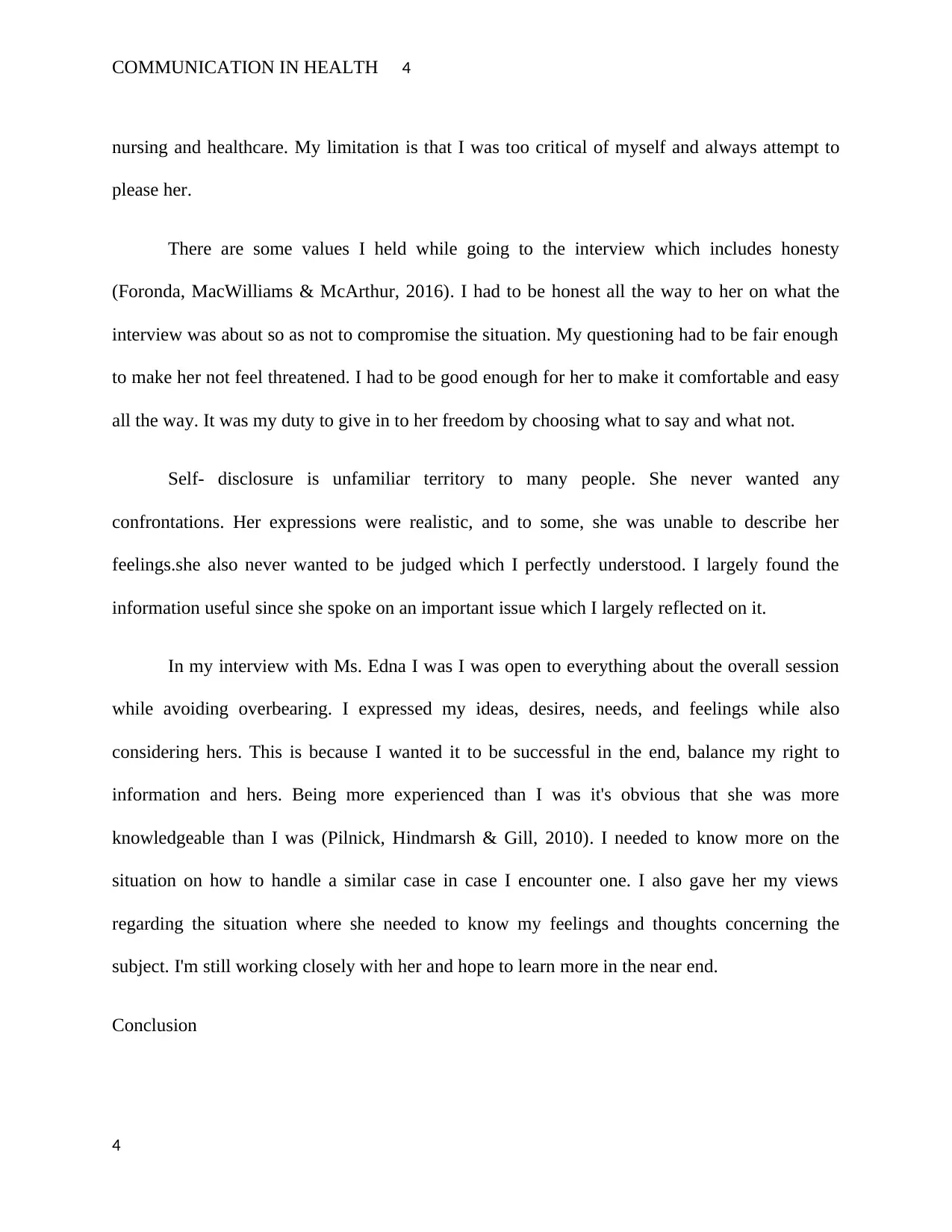
COMMUNICATION IN HEALTH 4
nursing and healthcare. My limitation is that I was too critical of myself and always attempt to
please her.
There are some values I held while going to the interview which includes honesty
(Foronda, MacWilliams & McArthur, 2016). I had to be honest all the way to her on what the
interview was about so as not to compromise the situation. My questioning had to be fair enough
to make her not feel threatened. I had to be good enough for her to make it comfortable and easy
all the way. It was my duty to give in to her freedom by choosing what to say and what not.
Self- disclosure is unfamiliar territory to many people. She never wanted any
confrontations. Her expressions were realistic, and to some, she was unable to describe her
feelings.she also never wanted to be judged which I perfectly understood. I largely found the
information useful since she spoke on an important issue which I largely reflected on it.
In my interview with Ms. Edna I was I was open to everything about the overall session
while avoiding overbearing. I expressed my ideas, desires, needs, and feelings while also
considering hers. This is because I wanted it to be successful in the end, balance my right to
information and hers. Being more experienced than I was it's obvious that she was more
knowledgeable than I was (Pilnick, Hindmarsh & Gill, 2010). I needed to know more on the
situation on how to handle a similar case in case I encounter one. I also gave her my views
regarding the situation where she needed to know my feelings and thoughts concerning the
subject. I'm still working closely with her and hope to learn more in the near end.
Conclusion
4
nursing and healthcare. My limitation is that I was too critical of myself and always attempt to
please her.
There are some values I held while going to the interview which includes honesty
(Foronda, MacWilliams & McArthur, 2016). I had to be honest all the way to her on what the
interview was about so as not to compromise the situation. My questioning had to be fair enough
to make her not feel threatened. I had to be good enough for her to make it comfortable and easy
all the way. It was my duty to give in to her freedom by choosing what to say and what not.
Self- disclosure is unfamiliar territory to many people. She never wanted any
confrontations. Her expressions were realistic, and to some, she was unable to describe her
feelings.she also never wanted to be judged which I perfectly understood. I largely found the
information useful since she spoke on an important issue which I largely reflected on it.
In my interview with Ms. Edna I was I was open to everything about the overall session
while avoiding overbearing. I expressed my ideas, desires, needs, and feelings while also
considering hers. This is because I wanted it to be successful in the end, balance my right to
information and hers. Being more experienced than I was it's obvious that she was more
knowledgeable than I was (Pilnick, Hindmarsh & Gill, 2010). I needed to know more on the
situation on how to handle a similar case in case I encounter one. I also gave her my views
regarding the situation where she needed to know my feelings and thoughts concerning the
subject. I'm still working closely with her and hope to learn more in the near end.
Conclusion
4
Paraphrase This Document
Need a fresh take? Get an instant paraphrase of this document with our AI Paraphraser
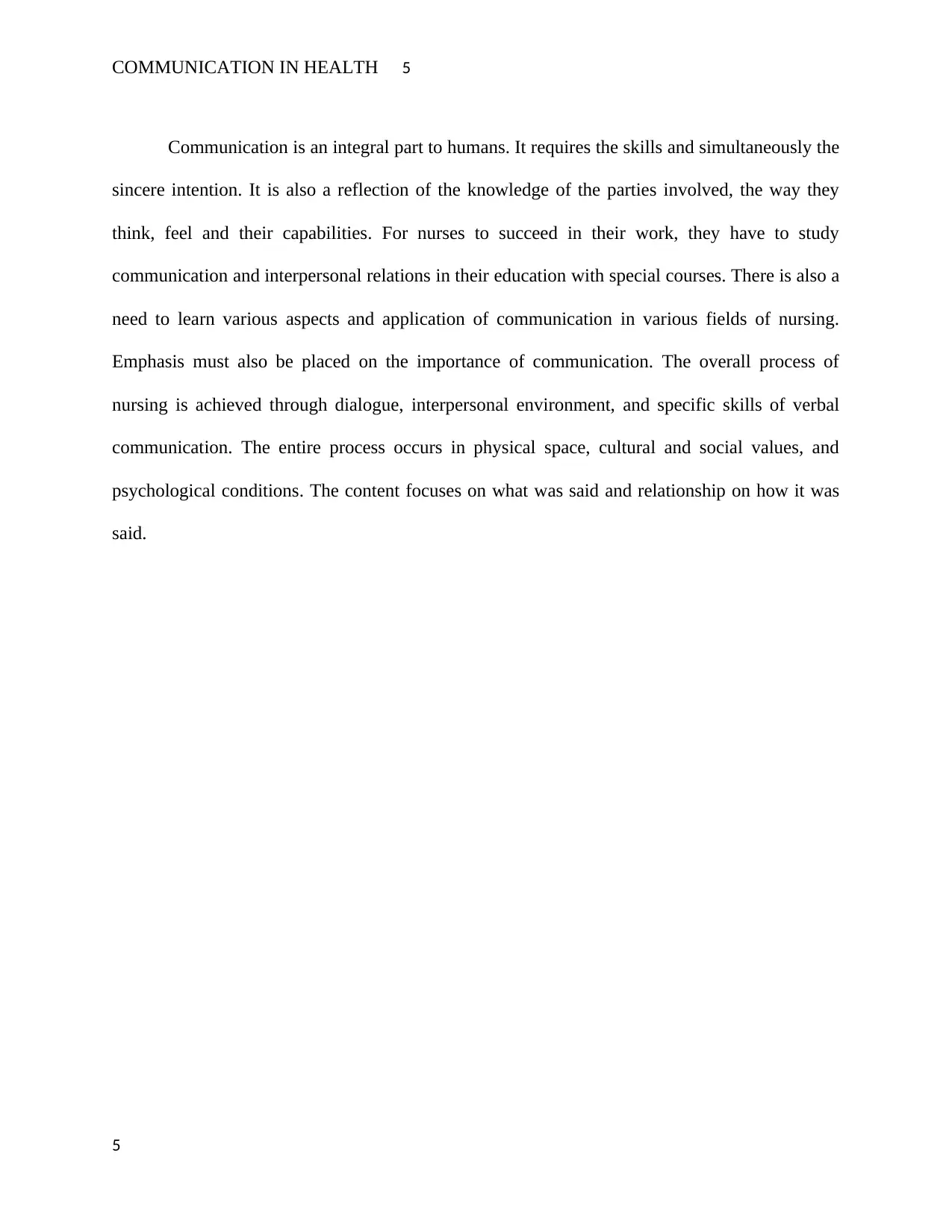
COMMUNICATION IN HEALTH 5
Communication is an integral part to humans. It requires the skills and simultaneously the
sincere intention. It is also a reflection of the knowledge of the parties involved, the way they
think, feel and their capabilities. For nurses to succeed in their work, they have to study
communication and interpersonal relations in their education with special courses. There is also a
need to learn various aspects and application of communication in various fields of nursing.
Emphasis must also be placed on the importance of communication. The overall process of
nursing is achieved through dialogue, interpersonal environment, and specific skills of verbal
communication. The entire process occurs in physical space, cultural and social values, and
psychological conditions. The content focuses on what was said and relationship on how it was
said.
5
Communication is an integral part to humans. It requires the skills and simultaneously the
sincere intention. It is also a reflection of the knowledge of the parties involved, the way they
think, feel and their capabilities. For nurses to succeed in their work, they have to study
communication and interpersonal relations in their education with special courses. There is also a
need to learn various aspects and application of communication in various fields of nursing.
Emphasis must also be placed on the importance of communication. The overall process of
nursing is achieved through dialogue, interpersonal environment, and specific skills of verbal
communication. The entire process occurs in physical space, cultural and social values, and
psychological conditions. The content focuses on what was said and relationship on how it was
said.
5
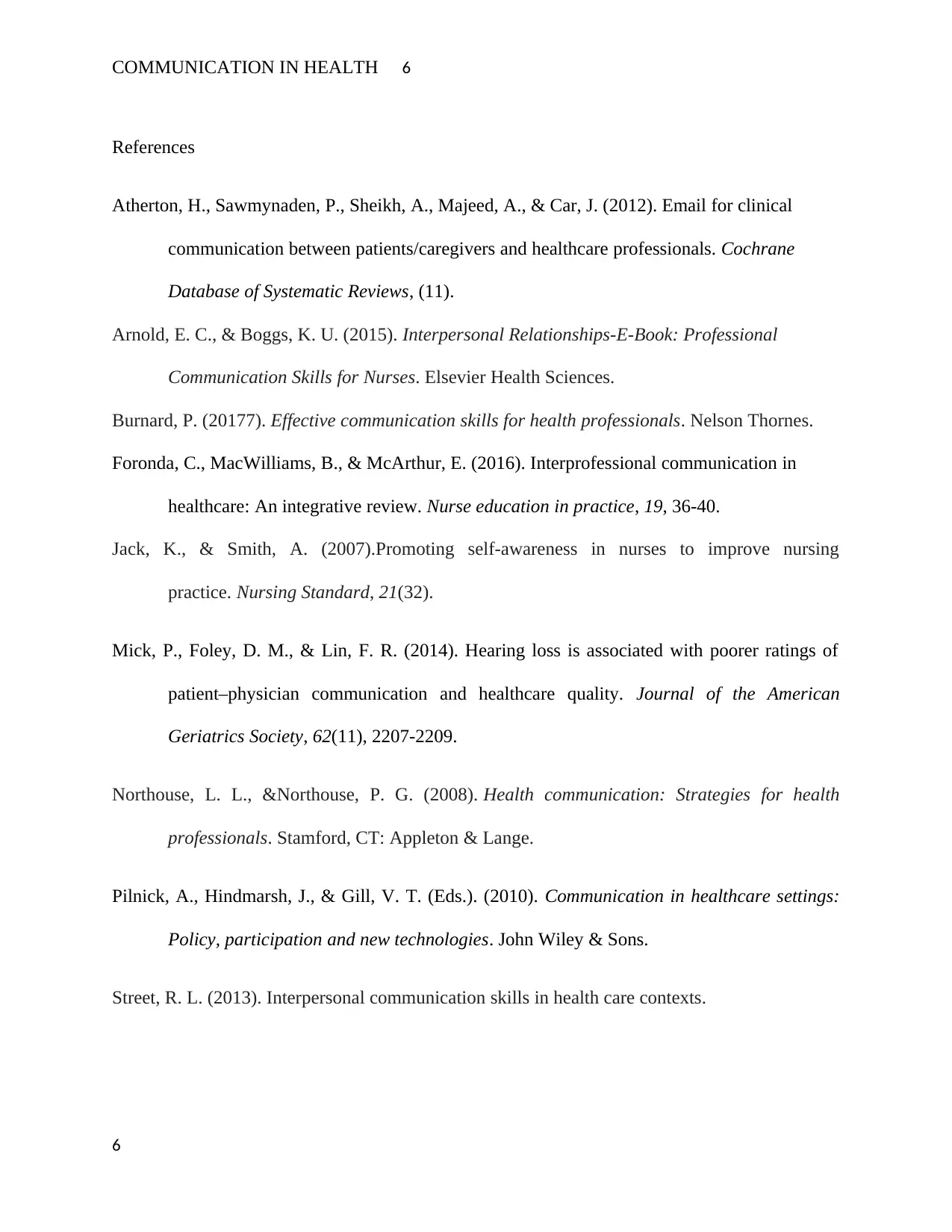
COMMUNICATION IN HEALTH 6
References
Atherton, H., Sawmynaden, P., Sheikh, A., Majeed, A., & Car, J. (2012). Email for clinical
communication between patients/caregivers and healthcare professionals. Cochrane
Database of Systematic Reviews, (11).
Arnold, E. C., & Boggs, K. U. (2015). Interpersonal Relationships-E-Book: Professional
Communication Skills for Nurses. Elsevier Health Sciences.
Burnard, P. (20177). Effective communication skills for health professionals. Nelson Thornes.
Foronda, C., MacWilliams, B., & McArthur, E. (2016). Interprofessional communication in
healthcare: An integrative review. Nurse education in practice, 19, 36-40.
Jack, K., & Smith, A. (2007).Promoting self-awareness in nurses to improve nursing
practice. Nursing Standard, 21(32).
Mick, P., Foley, D. M., & Lin, F. R. (2014). Hearing loss is associated with poorer ratings of
patient–physician communication and healthcare quality. Journal of the American
Geriatrics Society, 62(11), 2207-2209.
Northouse, L. L., &Northouse, P. G. (2008). Health communication: Strategies for health
professionals. Stamford, CT: Appleton & Lange.
Pilnick, A., Hindmarsh, J., & Gill, V. T. (Eds.). (2010). Communication in healthcare settings:
Policy, participation and new technologies. John Wiley & Sons.
Street, R. L. (2013). Interpersonal communication skills in health care contexts.
6
References
Atherton, H., Sawmynaden, P., Sheikh, A., Majeed, A., & Car, J. (2012). Email for clinical
communication between patients/caregivers and healthcare professionals. Cochrane
Database of Systematic Reviews, (11).
Arnold, E. C., & Boggs, K. U. (2015). Interpersonal Relationships-E-Book: Professional
Communication Skills for Nurses. Elsevier Health Sciences.
Burnard, P. (20177). Effective communication skills for health professionals. Nelson Thornes.
Foronda, C., MacWilliams, B., & McArthur, E. (2016). Interprofessional communication in
healthcare: An integrative review. Nurse education in practice, 19, 36-40.
Jack, K., & Smith, A. (2007).Promoting self-awareness in nurses to improve nursing
practice. Nursing Standard, 21(32).
Mick, P., Foley, D. M., & Lin, F. R. (2014). Hearing loss is associated with poorer ratings of
patient–physician communication and healthcare quality. Journal of the American
Geriatrics Society, 62(11), 2207-2209.
Northouse, L. L., &Northouse, P. G. (2008). Health communication: Strategies for health
professionals. Stamford, CT: Appleton & Lange.
Pilnick, A., Hindmarsh, J., & Gill, V. T. (Eds.). (2010). Communication in healthcare settings:
Policy, participation and new technologies. John Wiley & Sons.
Street, R. L. (2013). Interpersonal communication skills in health care contexts.
6
⊘ This is a preview!⊘
Do you want full access?
Subscribe today to unlock all pages.

Trusted by 1+ million students worldwide
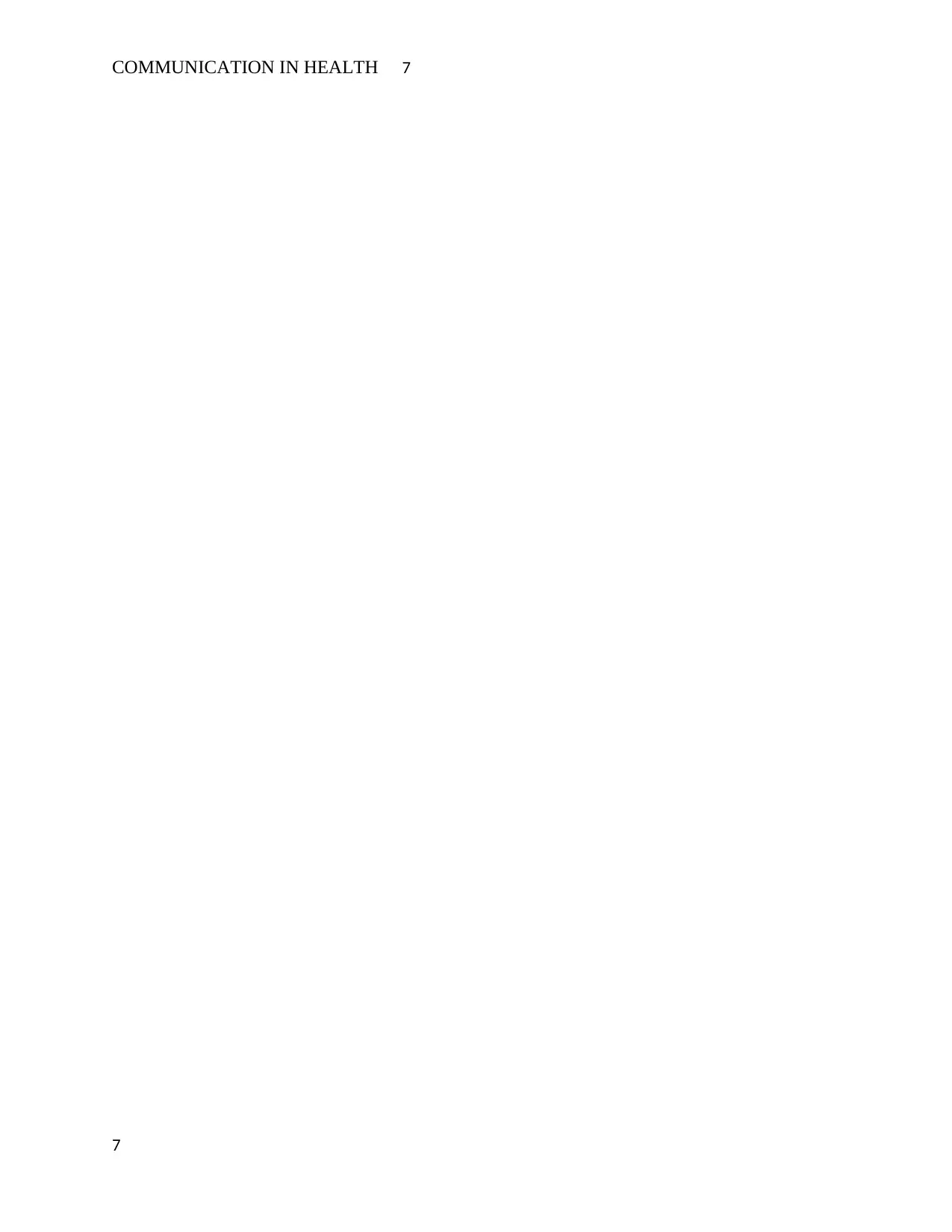
COMMUNICATION IN HEALTH 7
7
7
1 out of 7
Related Documents
Your All-in-One AI-Powered Toolkit for Academic Success.
+13062052269
info@desklib.com
Available 24*7 on WhatsApp / Email
![[object Object]](/_next/static/media/star-bottom.7253800d.svg)
Unlock your academic potential
Copyright © 2020–2025 A2Z Services. All Rights Reserved. Developed and managed by ZUCOL.




